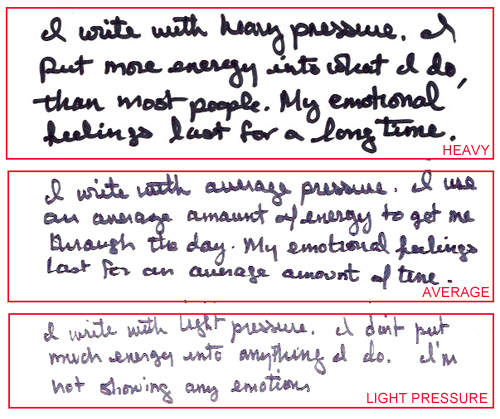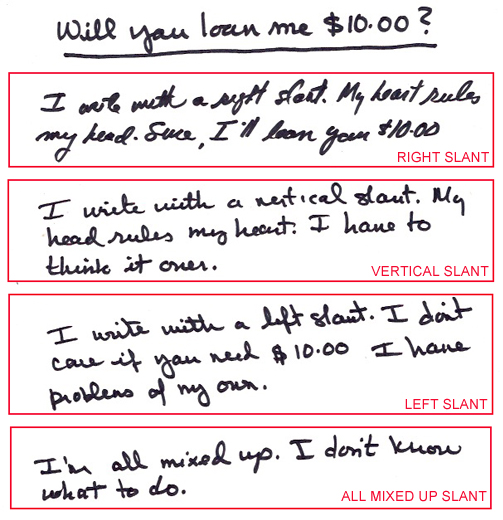
  See large photo and post your analysis Here. |
Handwriting Analysis- What is it?
Handwriting analysis, or graphology, is the science involved in producing a personality profile of the writer by examining the characteristics, traits and strokes of an individual's handwriting. I know it seems impossible, but a trained graphologist can gather an astonishing amount of information about the writer just from analyzing their handwriting. Besides creating a complete personality profile, many other things are revealed in your handwriting, such as health issues, morality, past experiences, hidden talents, mental problems-- to name just a few.
How it works
Your brain guides your hand. Everything put on paper is a result of a two-way circuit between your brain and the motor reflex muscles of your hand. Thus, your handwriting becomes a Polygraph or Oscilloscope read-out of your "complete self." To you, it's just handwriting, but to a handwriting analyst, it paints a picture of the person "behind the pen."
How to Begin
When analyzing writing style, first look at the handwriting in general, much like you would a painting. Make mental notes of the most outstanding traits and try to get a general feeling of the writer. (After 20 years of experience I can usually put the writer in a category right away.) Then, determine the emotional energy of the writer. This is the most important factor of the personality of the writer.
The emotional energy has a direct impact on every other trait displayed in the handwriting. Emotional energy is determined by how much pressure the writer uses when he writes. If you examine the writing you can determine how much pressure was used by how "dark" the writing is. Also, if you turn the page over and feel the underside you can feel how much pressure was used (especially if the sample was written on a soft surface).

Emotional energy is a combination of the physical and mental energy level. Writers with heavy pressure are usually highly successful. They have a lot of vitality and their emotional experiences last for a long time. Writers who write with average pressure are usually moderately successful and usually have enough energy to make it through the day. Those with light pressure try to avoid energy draining situations.
The Slant of the Writing: What Does it Mean?
The slant is the second indicator to look for. The slant indicates the writers emotional response to external forces. A right slant (////) signals one who responds strongly to emotional situations. They are caring, warm and outgoing -- their heart rules their mind. A vertical slant (llll) writer tries to keep their emotions in check -- mind rules their heart. A left slant writer (\\\\) will conceal their emotions and is observed as cold and indifferent.

Putting it Together.
Now let's mix some of these traits and see what we come up with.
1. A writer with heavy pressure and a vertical slant:
Heavy pressure = strong emotions and vertical slant = trying to hold emotions back. This writer is usually the one who keeps his wits about him. When "all hell breaks loose," his head rules. He will not be as emotionally responsive as a right slant writer and will "keep cool".
This "heavy pressure-vertical slant" writer won't be able to keep his cool all of the time. When his emotions get the best of him he may "fly off the handle" at unpredictable times.
2. A person with light pressure writing (not much emotional or physical energy) and a left slant (tries to avoid emotional situations): This person will be emotionally withdrawn, cold, indifferent and self centered.
There are many steps involved in creating a complete personality profile. Using these first two steps you can begin to put together your own "profile" which can be useful in both personal and professional relationships.
Some interesting facts about modern Graphology:
Handwriting-based Tool Offers Alternate Lie Detection Method
According to ScienceDaily, for ages experts and laymen have been analyzing and trying to crack the code of handwriting characteristics, in order to detect an individual's personality traits, or in most cases, gauge their innocence in the case of a crime. Although this science has often gone the way of pseudoscience, researchers are now discovering that with the aid of a computerized tool, handwriting characteristics can be measured more effectively.
The research, headed by Gil Luria and Sara Rosenblum at the University of Haifa, is published Applied Cognitive Psychology. The researchers utilized a computerized tablet that measured the physical properties of the subject's handwriting, which are difficult to consciously control (for example: the duration of time that the pen is on paper versus in the air, the length height and width of each writing stroke, the pressure implemented on the writing surface). They have found that these handwriting characteristics differ when an individual is in the process of writing deceptive sentences as opposed to truthful sentences.
The handwriting tool has the potential to replace, or work in tandem, with popular, verbal-based lie detection technology such as the polygraph to ensure greater accuracy and objectivity in law enforcement deception detection.
Additionally, polygraphs are often intrusive to the subject and sometimes inconclusive. The handwriting tool therefore provides ease and increased accuracy over common, verbal-based methods.
|
Twenty years ago, Gary Thomas purchased a paperback book for one dollar. The title? Analyze Handwriting in 10 Minutes. Gary didn't stop there. He purchased every book he could find about handwriting analysis, and began to develop his skills by taking courses on the subject. Eventually, Gary went on to study criminal justice and psychology at the University of Cincinnati.
According to Gary Thomas, "Handwriting analysis is a very useful tool. With it you can understand why people do the things they do. It also gives you the upper hand when dealing with strangers." Gary has shared the first two of nine steps he uses in creating a complete profile. Continue and learn more. |


 Today, he keeps busy with cases he describes as "exciting, but confidential." He is often called upon to "track" down the author of a threatening note, verify forgery, or develop a personality profile on a suspect in a criminal case.
Today, he keeps busy with cases he describes as "exciting, but confidential." He is often called upon to "track" down the author of a threatening note, verify forgery, or develop a personality profile on a suspect in a criminal case.